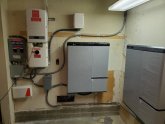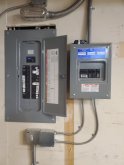6.12KW peak system (17 panels - 360W LG NEON) on west facing roof. I defined one cycle of my batteries as 80% DOD. Computed based off the 15 minute interval data provided by solaredge. We have EVs so our TOU means that off peak is around 13-15 cents/kwh, partial peak is 24-28 cents/kwh and peak is 34-48 cents/kwh (the range is based on different numbers depending on the season). This is how we were able to generate a lot less than what we used but much of our consumption was moved to off peak (over night) so that helped quite a bit. Note that our house is 100% electric - the furnace was replaced with heat pumps, the water heater is a heat pump and even our dryer is a heat pump! I am noticing a trend here....
Annual (numbers in Kilowatt Hour):
Total Production: 7,844.19
Total Consumption: 11,533.47
Battery:
Total Cycles: 281.93
Per Day (all numbers in watt-hours):
Median Production: 21,965.36
Median Consumption: 29,417.86
5th Percentile Production: 4,516.55
5th Percentile Consumption: 13,293.93
95th Percentile Production: 37,383.27
95th Percentile Consumption: 55,234.24




